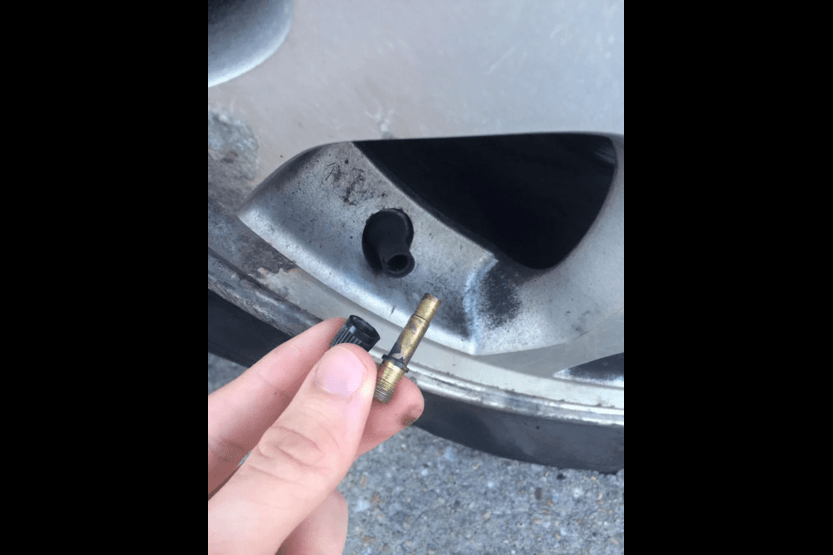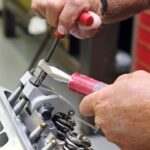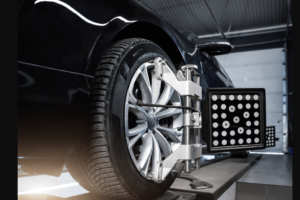When it comes to maintaining a car, one of the most important things to keep an eye on is tire pressure.
Low tire pressure can lead to decreased fuel efficiency, reduced tire life, and even dangerous blowouts on the road.
However, what do you do if you have a broken valve stem and can’t easily add air to your tire?
Fortunately, there are several ways to put air in a tire with a broken valve stem. One option is to use a valve core tool to remove the damaged valve stem and replace it with a new one.
Another option is to use a tire plug kit or tubeless tire repair kit to temporarily seal the valve stem and allow air to be added.
It’s important to note that while these methods can be effective, they are not permanent solutions.
It’s still crucial to have the valve stem properly repaired or replaced as soon as possible to ensure safe and reliable driving.
With that in mind, let’s take a closer look at how to put air in a tire with a broken valve stem.
Identifying a Broken Valve Stem

When it comes to tire maintenance, one of the most common issues is a broken valve stem. A valve stem is the small, rubber tube that protrudes from the wheel and allows air to enter and exit the tire. It is a crucial component of the tire’s inflation system. A broken valve stem can cause air to escape from the tire, leading to a flat tire. Here are some signs to look for to identify a broken valve stem:
Signs of Valve Stem Damage
- Air escaping: One of the most obvious signs of a broken valve stem is air escaping from the tire. If you hear a hissing sound or notice the tire is losing air quickly, it could be a sign that the valve stem is damaged.
- Deflate the tire: Another way to check if the valve stem is broken is by deflating the tire. If the valve stem is damaged, it may not allow air to enter the tire when you try to inflate it.
- Slow leak: A broken valve stem can also cause a slow leak in the tire. If you notice that the tire is losing air slowly over time, it could be a sign that the valve stem is damaged.
Consequences of a Faulty Valve Stem
If you suspect that your tire’s valve stem is damaged, it is important to get it fixed as soon as possible. A broken valve stem can cause several problems, including:
- Flat tire: The most obvious consequence of a faulty valve stem is a flat tire. If the valve stem is damaged, air will escape from the tire, causing it to go flat.
- Difficulty inflating the tire: A damaged valve stem can make it difficult to inflate the tire. This can be frustrating and time-consuming, especially if you are trying to get back on the road quickly.
- Increased risk of an accident: A flat tire can increase the risk of an accident, especially if it happens while you are driving. It can cause the vehicle to lose control and potentially lead to a serious accident.
How to Put Air in Tire With Broken Valve Stem

Putting air in a tire with a broken valve stem can be a challenging task, but it is not impossible. There are several ways to inflate a tire with a broken valve stem, and the method you choose will depend on the extent of the damage.
One option is to use a reamer tool to roughen and widen the hole, insert a plug with an insertion tool to seal the hole, and then install a valve stem extension which fits over the broken stem, allowing you to attach an air hose and inflate the tire. This method is suitable for temporary fixes and can get you back on the road quickly. [1]
If the valve core of your tire is still intact within the broken valve stem, you can use an air compressor and a valve core tool to inflate your tire. This involves removing the valve core, inflating the tire, and quickly replacing the valve core while the air tries to escape. [2]
Another option is to jack up the car and loosen the tire, remove the broken valve stem, and replace it with a new one. This method is more permanent and requires more effort, but it is a reliable long-term solution. [3]
It is important to note that if the tire is severely damaged, it may be safer to replace it entirely. In any case, it is crucial to address the issue promptly to avoid further damage to the tire or the vehicle.
Temporary Solutions and Safety Precautions
How to Temporarily Fix a Broken Valve Stem
A broken valve stem can cause a tire to lose air quickly, leaving you stranded on the road. However, there are temporary solutions that can help you inflate the tire and make it hold air until you can get it fixed properly.
One such solution is to use an air compressor and a valve core tool to inflate the tire through the valve core. To do this, you will need to remove the valve core from the stem using the valve core tool and then attach the air compressor to the valve stem. Once the tire is inflated, you can replace the valve core and check if the tire holds air.
Another temporary solution is to use a tire sealant, which can help seal any leaks in the tire caused by the broken valve stem. To use a tire sealant, you will need to remove the valve core from the stem and then inject the sealant into the tire through the valve stem. Once the sealant is inside the tire, you can inflate the tire and check if it holds air.
Safety Measures When Dealing With Tire Issues
When dealing with tire issues, it is important to take certain safety measures to avoid accidents and injuries. Before attempting to inflate a tire with a broken valve stem, it is important to make sure that the tire is not damaged or worn out. You can do this by checking the tire for any cracks, cuts, or punctures. If the tire is damaged, it is best to replace it instead of trying to inflate it.
Another safety measure is to use soapy water to check for any leaks in the tire. To do this, you can mix some dish soap with water and apply the solution to the tire with a spray bottle. If there are any leaks in the tire, the soapy water will create bubbles at the site of the leak. This can help you identify the source of the leak and fix it properly.
Finally, it is important to use proper equipment and follow the manufacturer’s instructions when inflating a tire. This includes using a tire pressure gauge to check the tire pressure and inflating the tire to the recommended pressure level. Overinflating or underinflating the tire can affect the tire’s performance and comfort, and can even lead to a blowout or other tire-related issues.
Replacing a Broken Valve Stem
Tools and Materials Needed for Replacement
Before replacing a broken valve stem, there are some tools and materials that are required. These include a new valve stem, pliers, a valve stem tool, a valve core tool, a tire machine, a tire iron, and a DIY repair kit.
The new valve stem can be purchased at a local auto parts store or online. The valve stem tool is used to remove the old valve stem and install the new one. The valve core tool is used to remove and replace the valve core.
Pliers are used to remove the valve stem cap and to grip the valve stem during the replacement process. A tire machine is used to remove the tire from the rim, while a tire iron is used to pry the tire off the rim.
Step-by-Step Valve Stem Replacement Guide
- Remove the valve stem cap using pliers.
- Use the valve stem tool to remove the old valve stem.
- Insert the new valve stem into the valve stem hole and tighten it using the valve stem tool.
- Use the valve core tool to remove the old valve core.
- Insert a new valve core using the valve core tool.
- Reinflate the tire using a tire machine or DIY repair kit.
- Replace the valve stem cap.
It is important to note that valve stem replacement can be a complex process and may require professional assistance. If unsure about how to replace a valve stem, it is recommended to seek the help of a professional mechanic.
Professional Repair and Maintenance

When to Seek Professional Tire Repair Services
While it is possible to repair a tire with a broken valve stem, it is not always a recommended solution. A professional tire repair service can assess the damage and determine if a simple repair is enough or if the tire needs to be replaced altogether.
If the tire is showing signs of wear and tear, such as cracks or bulges, it is best to dispose of it and purchase a new one. A blowout caused by a damaged tire can be dangerous and potentially life-threatening.
Maintaining Tires to Prevent Valve Stem Issues
Regular maintenance of tires can prevent valve stem issues from occurring in the first place. It is important to check tire pressure regularly and keep tires properly inflated. This can be done at a gas station or a tire shop.
Additionally, it is important to inspect tires for any signs of wear and tear, such as cracks or bulges. If any issues are found, it is best to seek professional repair services or dispose of the tire and purchase a new one.
By maintaining tires properly, drivers can prevent issues with valve stems and other tire-related problems. This can not only save money on costly repairs but also prevent dangerous blowouts while driving.
Final Thoughts
Putting air in a tire with a broken valve stem can be a frustrating experience. However, with the right tools and knowledge, it is a manageable task. The first step is to identify the problem. If the valve stem is completely broken off, then it will need to be replaced before any air can be added to the tire.
If the valve stem is only partially broken, then it may be possible to add air to the tire. One method is to use pliers to grip the remaining piece of the valve stem and pull it out of the tire. Then, a valve stem replacement kit can be used to install a new valve stem.
Another method is to use a valve stem extension. This is a small device that attaches to the end of the valve stem and allows air to be added to the tire. Valve stem extensions can be purchased at most auto parts stores and are easy to install.
It is important to remember that adding air to a tire with a broken valve stem is only a temporary solution. It is essential to replace the valve stem as soon as possible to prevent further damage to the tire.
In summary, putting air in a tire with a broken valve stem is a task that can be accomplished with the right tools and knowledge. Identifying the problem and using the appropriate method to add air to the tire is crucial. It is important to keep in mind that replacing the valve stem is necessary for long-term tire health.









![Read more about the article Where Are Falken Tires Made? [Falken Tire Review]](https://roadsumo.com/wp-content/uploads/2021/06/where-are-falken-tires-made-300x200.jpg)